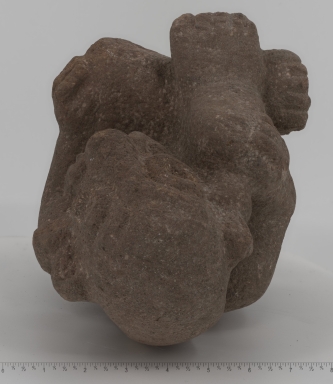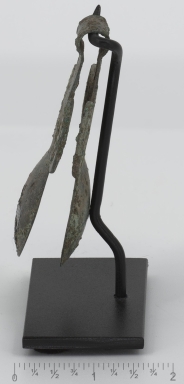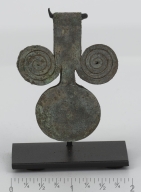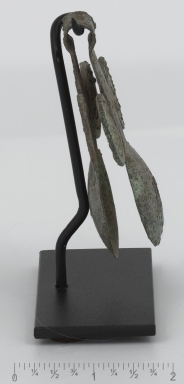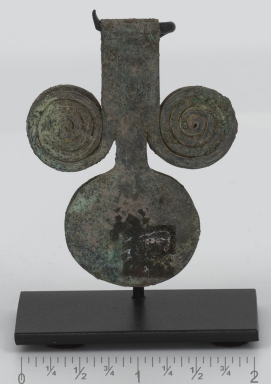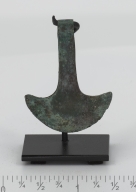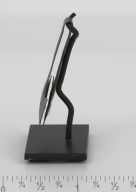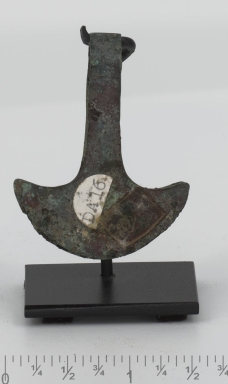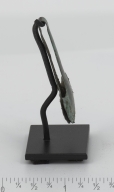|
REFINE
Browse All : Indigenous peoples--Antiquities and Aztec sculpture--Mexico and ArtifactTitle
Aztec stone sculpture.
Description
Elaborate twisted hairdo: knotted on top -- possibly a female. Concentrations of broken figurines (flat) in household context or debris rather than public buildings or temples suggest a personal or family context. the figurine called "ginger bread" flats, were manufactured by pressing wet clay into clay molds. They were removed for drying, firing, and painting. Fingerprints on the back.
Subject
[Aztec sculpture--Mexico, Stone carving--Mexico, Art--Mexico, Indigenous peoples--Antiquities]
Date
between 100 and 1425
Title
Tweezers : spherical pinchers.
Description
Tweezers were very common in the Central South American Andes, but not in Mesoamerica. The elite Tarascans wore tweezers as a pendant. They probably were more than an object to remove facial hair. The tweezers were more like badge of office or status.
Subject
[Aztec sculpture--Mexico, Metal sculpture--Mexico, Art--Mexico, Indigenous peoples--Antiquities]
Date
between 900 and 1200
Title
Tweezers : spherical pinchers.
Description
Tweezers were very common in the Central South American Andes, but not in Mesoamerica. The elite Tarascans wore tweezers as a pendant. They probably were more than an object to remove facial hair. The tweezers were more like badge of office or status.
Subject
[Aztec sculpture--Mexico, Metal sculpture--Mexico, Art--Mexico, Indigenous peoples--Antiquities]
Date
between 900 and 1200
Title
Tweezers : spherical pinchers.
Description
Tweezers were very common in the Central South American Andes, but not in Mesoamerica. The elite Tarascans wore tweezers as a pendant. They probably were more than an object to remove facial hair. The tweezers were more like badge of office or status.
Subject
[Aztec sculpture--Mexico, Metal sculpture--Mexico, Art--Mexico, Indigenous peoples--Antiquities]
Date
between 900 and 1200
Title
Tweezers : spherical pinchers.
Description
Tweezers were very common in the Central South American Andes, but not in Mesoamerica. The elite Tarascans wore tweezers as a pendant. They probably were more than an object to remove facial hair. The tweezers were more like badge of office or status.
Subject
[Aztec sculpture--Mexico, Metal sculpture--Mexico, Art--Mexico, Indigenous peoples--Antiquities]
Date
between 900 and 1200
Title
Tweezers, crescent pinchers : plain.
Description
Tweezers were formed from a single sheet of copper and folded over at the top. The mirror images joined in the middle had to be formed or cut out of a sheet of copper. The crescent-shape ends were hammered convex before folding.
Subject
[Aztec sculpture--Mexico, Metal sculpture--Mexico, Art--Mexico, Indigenous peoples--Antiquities]
Date
between 900 and 1201
Title
Tweezers, crescent pinchers : plain.
Description
Tweezers were formed from a single sheet of copper and folded over at the top. The mirror images joined in the middle had to be formed or cut out of a sheet of copper. The crescent-shape ends were hammered convex before folding.
Subject
[Aztec sculpture--Mexico, Metal sculpture--Mexico, Art--Mexico, Indigenous peoples--Antiquities]
Date
between 900 and 1201
Title
Tweezers, crescent pinchers : plain.
Description
Tweezers were formed from a single sheet of copper and folded over at the top. The mirror images joined in the middle had to be formed or cut out of a sheet of copper. The crescent-shape ends were hammered convex before folding.
Subject
[Aztec sculpture--Mexico, Metal sculpture--Mexico, Art--Mexico, Indigenous peoples--Antiquities]
Date
between 900 and 1201
Title
Tweezers, crescent pinchers : plain.
Description
Tweezers were formed from a single sheet of copper and folded over at the top. The mirror images joined in the middle had to be formed or cut out of a sheet of copper. The crescent-shape ends were hammered convex before folding.
Subject
[Aztec sculpture--Mexico, Metal sculpture--Mexico, Art--Mexico, Indigenous peoples--Antiquities]
Date
between 900 and 1201
|
